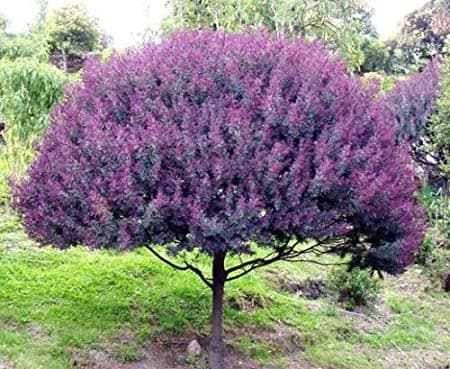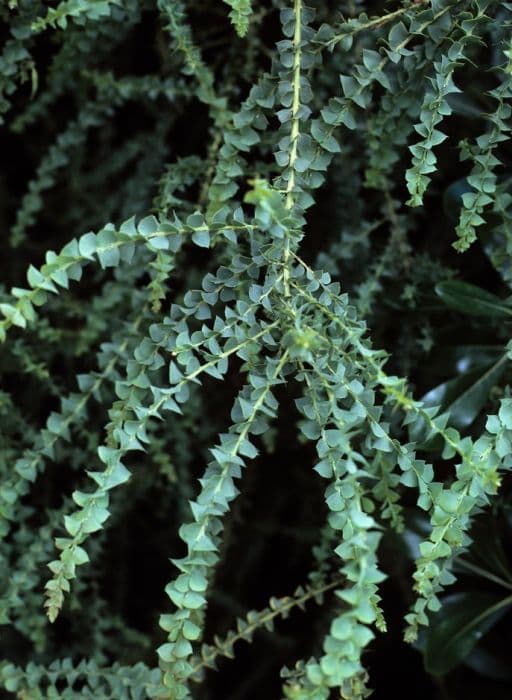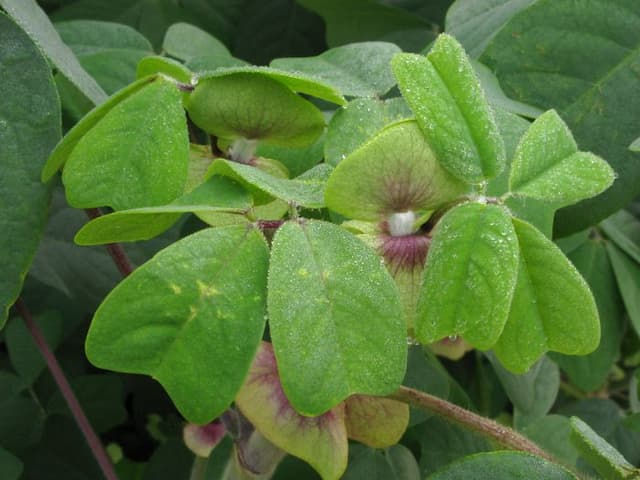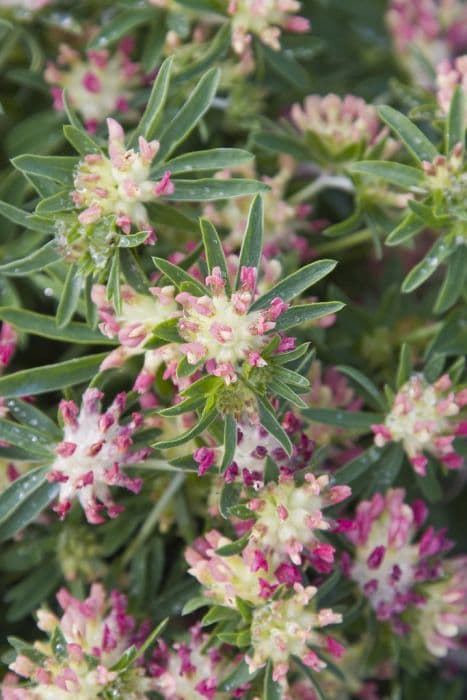Chinese Redbud Cercis chinensis
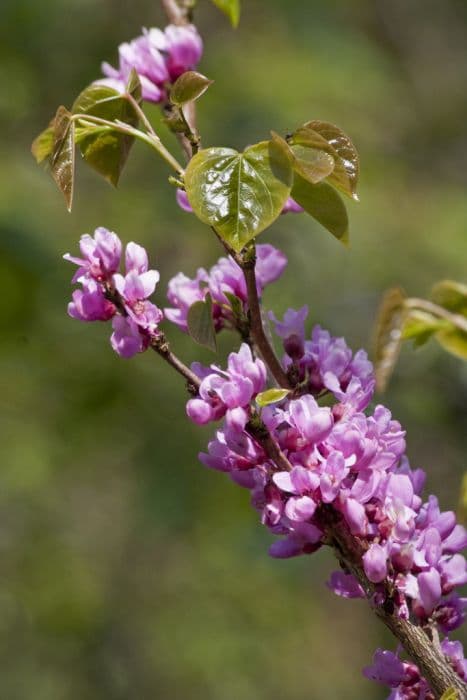
ABOUT
Cercis chinensis, commonly known as the Chinese redbud, is a deciduous shrub or small tree known for its stunning floral display. It features a multi-stemmed, spreading habit with gracefully arching branches. The bark is smooth and gray, providing a lovely contrast against the foliage and flowers. In early spring, before the leaves emerge, the Chinese redbud bursts into an eye-catching exhibition of color. It is adorned with clusters of small, pea-like flowers that blank the branches. These blossoms come in various shades of pink and sometimes white, enveloping the plant in a cloud of delicate blooms that are both vibrant and showy. After the flowering period, heart-shaped leaves appear. They are glossy and have a leathery texture, starting as a reddish color when young and maturing to a rich green as the season progresses. In autumn, the foliage transforms again, this time into a lovely yellow shade, adding a warm tone to the landscape. Throughout the year, the Chinese redbud's appearance offers a succession of visual interest, making it a desirable plant for gardeners looking to add lasting beauty to their outdoor spaces.
About this plant
 Names
NamesSynonyms
Chinese Redbud, Eastern Redbud
Common names
Cercis chinensis var. chinensis, Cercis paucijuga, Cercis yunnanensis.
 Toxicity
ToxicityTo humans
The Chinese redbud (Cercis chinensis) is not widely known to be toxic to humans. There is limited information on its toxicity, so it's always wise to exercise caution and not ingest parts of ornamental plants without proper knowledge of their edibility and potential effects. If a plant is determined to be poisonous, symptoms of poisoning can range from mild gastrointestinal distress to more severe reactions, depending on the plant and the part ingested.
To pets
For pets, Chinese redbud is not specifically listed as toxic. However, as with humans, there is often limited information on the toxicity of various plants to animals, and individual pets might have different sensitivities or allergic reactions to plants. Therefore, it's always best to prevent pets from ingesting plants that are not confirmed to be safe. If a pet ingests a poisonous plant, symptoms could include vomiting, diarrhea, lethargy, or more severe conditions depending on the plant and the amount ingested. In any case of suspected poisoning, it is important to consult a veterinarian.
 Characteristics
CharacteristicsLife cycle
Perennials
Foliage type
Deciduous
Color of leaves
Green
Flower color
Pink
Height
20-30 feet (6-9 meters)
Spread
25-35 feet (7.5-10.5 meters)
Plant type
Tree
Hardiness zones
6-9
Native area
China
Benefits
 General Benefits
General Benefits- Landscape Aesthetics: Cercis chinensis, commonly known as Chinese redbud, has a striking spring bloom with an abundance of pink or purplish flowers, enhancing the visual appeal of gardens and landscapes.
- Wildlife Attraction: The flowers of the Chinese redbud provide nectar for pollinators, such as bees and butterflies, contributing to the support of local ecosystems.
- Shade Provision: As a small to medium-sized deciduous tree, the Chinese redbud can offer a pleasant shade in garden settings, making outdoor areas more enjoyable during warmer seasons.
- Seasonal Interest: Besides the vibrant spring flowers, the Chinese redbud offers changing colors throughout the seasons, with attractive heart-shaped leaves that turn yellow in the fall, keeping the landscape visually interesting year-round.
- Erosion Control: With its well-developed root system, the Chinese redbud can help stabilize the soil and prevent erosion on slopes or areas prone to soil loss.
- Urban Tolerance: The Chinese redbud is tolerant of urban conditions, including pollution and compacted soils, making it suitable for planting in city environments and streetscapes.
- Low Maintenance: Once established, Cercis chinensis is relatively low maintenance, requiring minimal care beyond occasional pruning and watering during prolonged dry periods.
- Habitat Diversity: The Chinese redbud can be incorporated into wildlife gardens or native plantings, contributing to the diversity of plant species and creating more robust habitat conditions for various organisms.
 Medical Properties
Medical PropertiesThis plant is not used for medical purposes.
 Air-purifying Qualities
Air-purifying QualitiesThis plant is not specifically known for air purifying qualities.
 Other Uses
Other Uses- Fabric Dye: The flowers of the Chinese redbud can be used to create natural dyes for fabrics, yielding colors in soft shades of pink and lavender.
- Woodwork: The wood of the Chinese redbud is hard and dense, making it suitable for small woodworking projects like making handles, fine furniture, or intricate carvings.
- Bonsai: Due to its attractive shape and floriferous nature, the Chinese redbud can be trained as a bonsai tree, providing a unique addition to this Japanese art.
- Photography Backdrop: Photographers may utilize the vibrant blooms of the Chinese redbud as a natural backdrop for springtime photo sessions.
- Wedding Decor: Branches laden with flowers can be used in wedding ceremonies for natural, spring-themed decorations or as part of bridal bouquets.
- Culinary Garnish: The edible flowers can be used as a colorful and slightly sweet garnish for salads and desserts.
- Educational Tool: Chinese redbud can be used in botany education to teach students about plant propagation, especially from cuttings or seeds.
- Artistic Inspiration: Artists may draw inspiration from the form and color of the Chinese redbud for paintings, drawings, and other forms of artwork.
- Beekeeping: The flowers of the Chinese redbud provide an excellent source of nectar and pollen for bees, enhancing local beekeeping endeavors.
- Holiday Decoration: During Easter and other spring holidays, branches of the Chinese redbud can be brought indoors for a natural decorative element that celebrates the season.
Interesting Facts
 Feng Shui
Feng ShuiThe Chinese Redbud is not used in Feng Shui practice.
 Zodiac Sign Compitability
Zodiac Sign CompitabilityThe Chinese Redbud is not used in astrology practice.
 Plant Symbolism
Plant Symbolism- Love and Affection: Often known as the Chinese redbud, Cercis chinensis is said to symbolize love and affection due to its heart-shaped leaves, suggesting the idea of giving one's heart to another.
- Renaissance and Renewal: The Chinese redbud blooms with vibrant flowers in early spring, making it a symbol of renaissance and renewal as it is one of the first plants to awaken from the winter slumber.
- Fertility and New Life: The prolific spring blossoms of the Chinese redbud represent fertility and new life, symbolizing the potential for growth and the start of new beginnings.
- Mystical Power: In some cultures, the Chinese redbud is thought to have mystical powers, offering protection and enchantment, and is connected with magical lore.
- Harmony: The graceful form and calming presence of the Chinese redbud suggest harmony with nature, inspiring people to live in balance with their environment.
 Water
WaterThe Chinese redbud should be watered deeply enough to moisten the soil to a depth of 6 to 8 inches, allowing the soil to dry out slightly between waterings. During the growing season, this typically means watering once a week, though in hotter, drier periods, twice a week may be necessary. Established trees are drought tolerant and may only require watering every two to three weeks, especially if there's natural rainfall. Aim to provide approximately 1 to 1.5 gallons of water per each watering session for young trees, and adjust for mature trees based on their size and the weather conditions.
 Light
LightThe Chinese redbud thrives in full sun to part shade conditions. It will perform best with at least six hours of direct sunlight each day. An ideal spot is one that provides morning sunlight with some dappled afternoon shade to protect from the intense late-day sun, especially in hotter climates.
 Temperature
TemperatureThe Chinese redbud is hardy and can tolerate a wide temperature range. It can survive minimum temperatures down to 0°F but prefers the temperature to be above 25°F to avoid damage to blossoms. The ideal temperature range for this tree is between 60°F and 85°F during the growing season.
 Pruning
PruningThe Chinese redbud should be pruned to maintain its shape, remove dead or crossed branches, and to encourage a strong structure. Prune in late winter or early spring before new growth starts, as this is when the tree is dormant and the wounds heal fastest. Light annual pruning is often enough to keep the tree healthy and looking its best.
 Cleaning
CleaningAs needed
 Soil
SoilChinese Redbud thrives in well-draining, fertile soil with a pH ranging from neutral to slightly alkaline. A good mix would include loamy soil, peat, and perlite to ensure adequate drainage. Regularly amend the soil with compost to maintain its fertility and structure.
 Repotting
RepottingChinese Redbud trees planted in containers may need repotting every 2-3 years to prevent root-bound conditions and to replenish nutrients in the soil. It's best to repot in early spring before new growth begins.
 Humidity & Misting
Humidity & MistingChinese Redbud does not have specific humidity requirements and can adapt to a wide range of conditions; however, it typically prefers average humidity levels similar to its native woodland habitats.
 Suitable locations
Suitable locationsIndoor
Place in bright, indirect light and water moderately.
Outdoor
Plant in well-draining soil; full sun to partial shade.
Hardiness zone
6-9 USDA
 Life cycle
Life cycleCercis chinensis, commonly known as the Chinese redbud, begins its life as a seed, which after stratification in cold temperatures, germinates in the spring. The seedling stage follows, where the plant develops its first true leaves and root system. As it grows into a juvenile, the Chinese redbud develops a woody stem and a branching structure. Upon reaching maturity, the plant produces distinctive heart-shaped leaves and in early spring, vibrant pink to purplish flowers emerge directly on the branches before the foliage unfolds. After flowering, the plant produces flat, bean-like seed pods that mature by late summer. These seeds are eventually dispersed, sometimes with the help of animals or wind, completing the life cycle as they give rise to new seedlings.
 Propogation
PropogationPropogation time
Spring
The most popular method of propagation for the Chinese redbud (Cercis chinensis) is by seed. Seeds should be collected in the fall once the pods have dried and turned brown. The seeds have a hard coat, which often requires scarification to enhance germination. This can be done by carefully nicking the seed coat with a knife or rubbing it with sandpaper. It's advisable to soak the seeds in warm water for 24 hours before sowing to further improve germination rates. Sowing should occur in the spring, after the danger of frost has passed. The seeds should be planted about 1/4 to 1/2 inch deep (approximately 6 to 13 mm) in well-draining soil and kept moist until germination, which typically occurs in 2-3 weeks.
